TOYOTA SEQUOIA 2020 Owners Manual (in English)
Manufacturer: TOYOTA, Model Year: 2020, Model line: SEQUOIA, Model: TOYOTA SEQUOIA 2020Pages: 588, PDF Size: 12.33 MB
Page 301 of 588
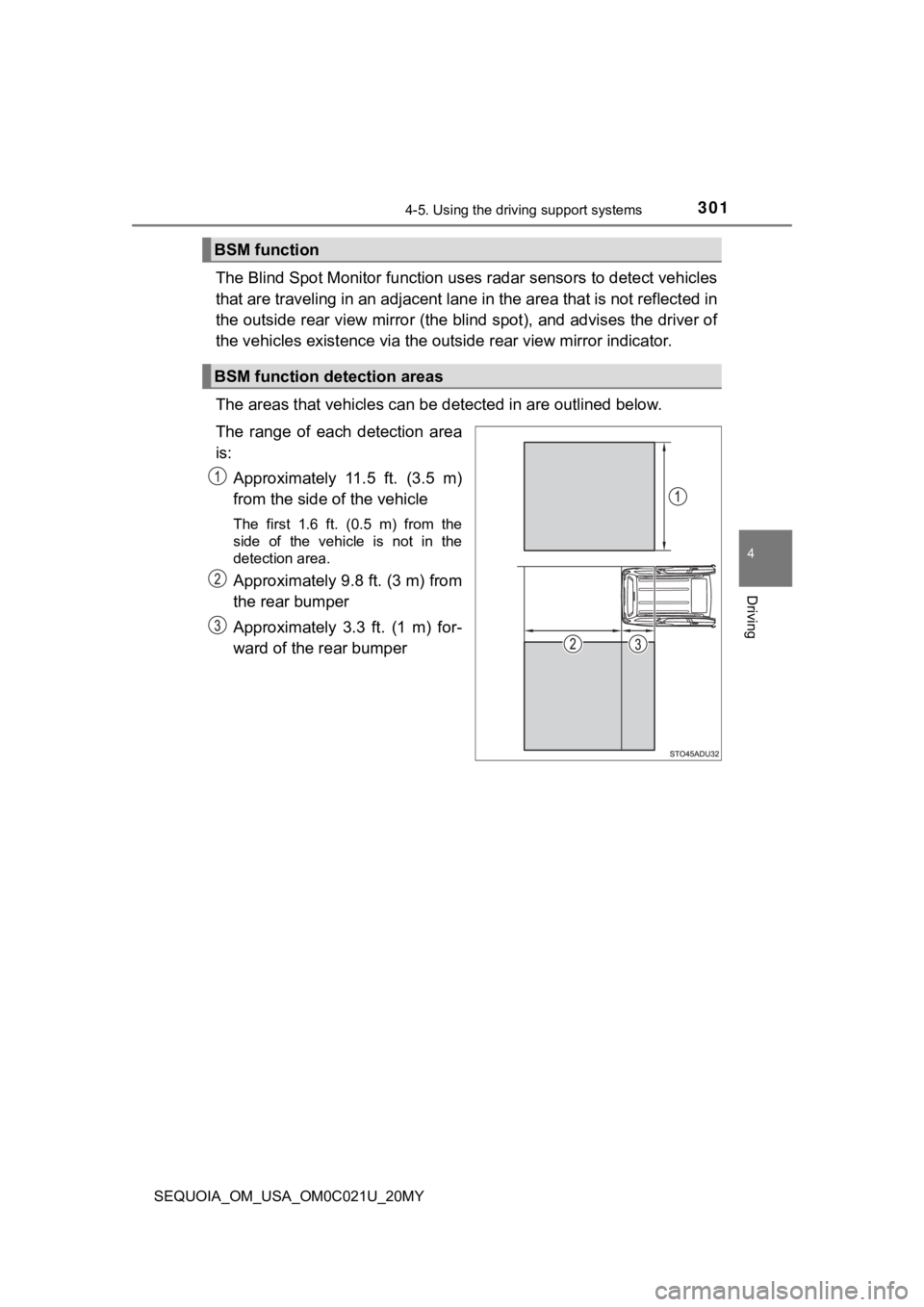
3014-5. Using the driving support systems
4
Driving
SEQUOIA_OM_USA_OM0C021U_20MY
The Blind Spot Monitor function uses radar sensors to detect vehicles
that are traveling in an adjacent lane in the area that is not reflected in
the outside rear view mirror (the blind spot), and advises the driver of
the vehicles existence via the outside rear view mirror indicat or.
The areas that vehicles can be detected in are outlined below.
The range of each detection area
is: Approximately 11.5 ft. (3.5 m)
from the side of the vehicle
The first 1.6 ft. (0.5 m) from the
side of the vehicle is not in the
detection area.
Approximately 9.8 ft. (3 m) from
the rear bumper
Approximately 3.3 ft. (1 m) for-
ward of the rear bumper
BSM function
BSM function detection areas
Page 302 of 588
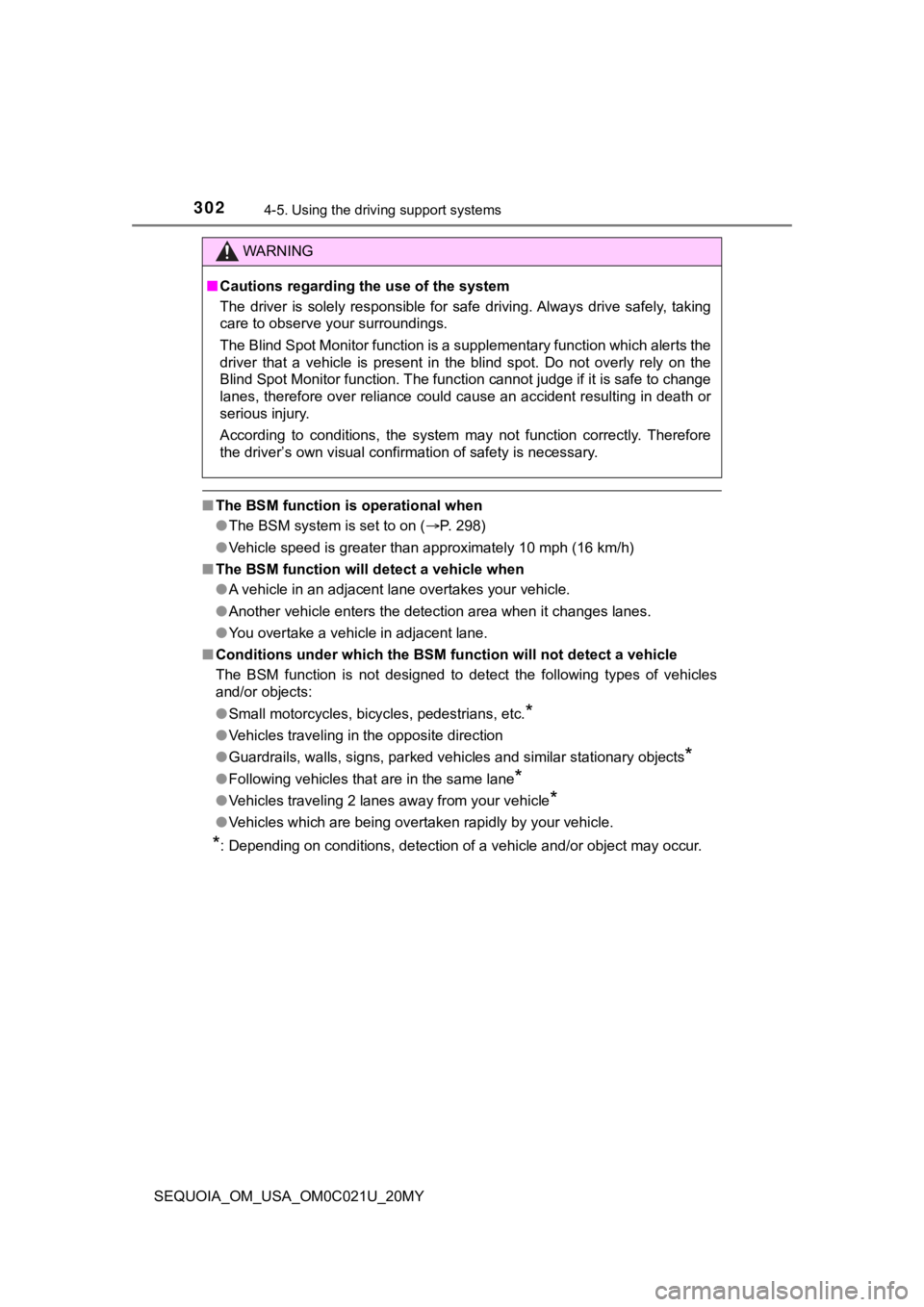
3024-5. Using the driving support systems
SEQUOIA_OM_USA_OM0C021U_20MY
■The BSM function is operational when
●The BSM system is set to on ( P. 298)
● Vehicle speed is greater than approximately 10 mph (16 km/h)
■ The BSM function will detect a vehicle when
●A vehicle in an adjacent lane overtakes your vehicle.
● Another vehicle enters the detection area when it changes lanes.
● You overtake a vehicle in adjacent lane.
■ Conditions under which the BSM function will not detect a vehicle
The BSM function is not designed to detect the following types of vehicles
and/or objects:
● Small motorcycles, bicycles, pedestrians, etc.
*
●Vehicles traveling in the opposite direction
● Guardrails, walls, signs, parked vehicles and similar stationar y objects
*
●Following vehicles that are in the same lane*
●Vehicles traveling 2 lanes away from your vehicle*
●Vehicles which are being overtaken rapidly by your vehicle.
*: Depending on conditions, detection of a vehicle and/or object may occur.
WARNING
■Cautions regarding the use of the system
The driver is solely responsible for safe driving. Always drive safely, taking
care to observe your surroundings.
The Blind Spot Monitor function is a supplementary function whi ch alerts the
driver that a vehicle is present in the blind spot. Do not over ly rely on the
Blind Spot Monitor function. The function cannot judge if it is safe to change
lanes, therefore over reliance could cause an accident resultin g in death or
serious injury.
According to conditions, the system may not function correctly. Therefore
the driver’s own visual confirmation of safety is necessary.
Page 303 of 588
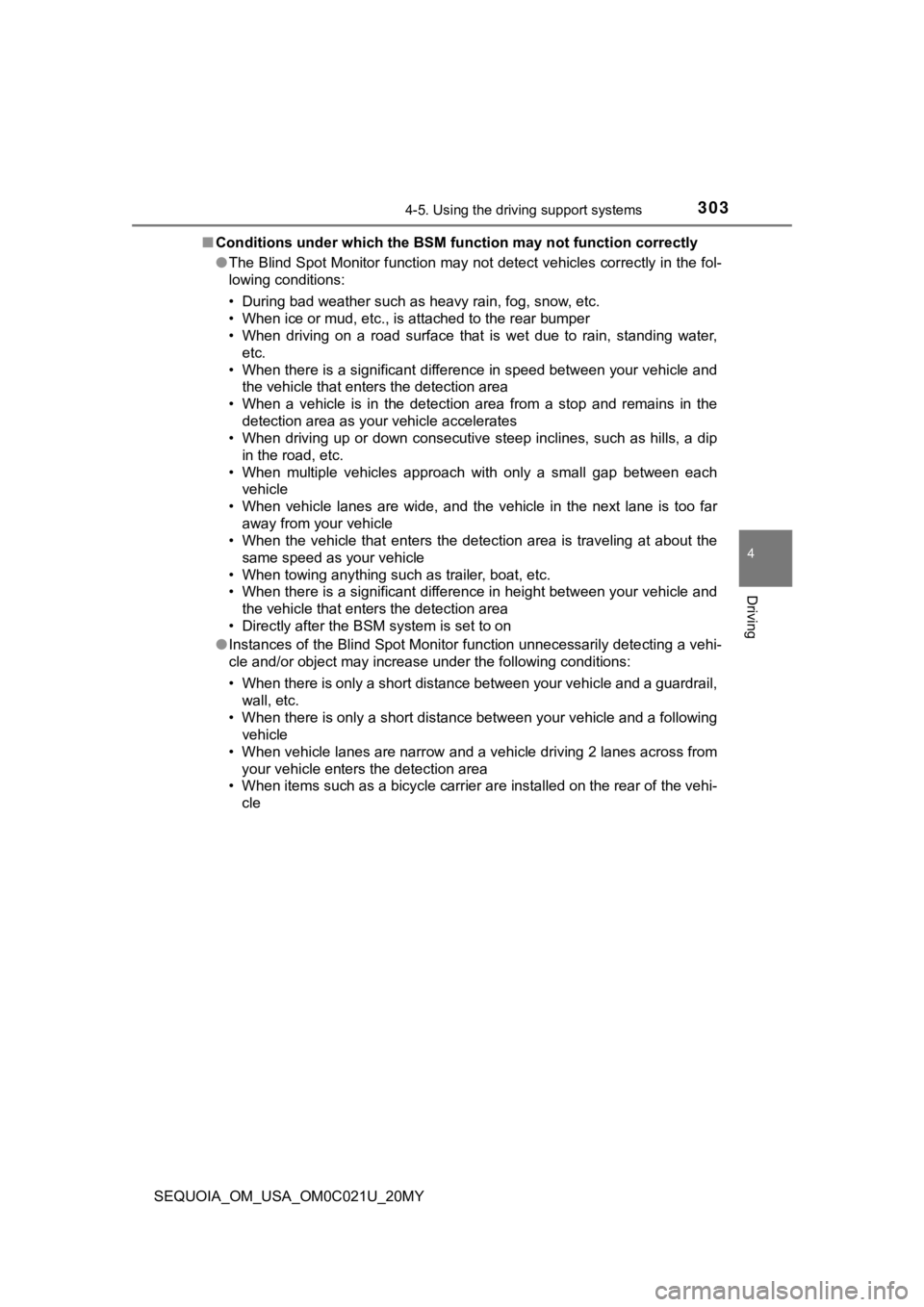
3034-5. Using the driving support systems
4
Driving
SEQUOIA_OM_USA_OM0C021U_20MY■
Conditions under which the BSM function may not function correc tly
● The Blind Spot Monitor function may not detect vehicles correct ly in the fol-
lowing conditions:
• During bad weather such as heavy rain, fog, snow, etc.
• When ice or mud, etc., is attached to the rear bumper
• When driving on a road surface that is wet due to rain, standi ng water,
etc.
• When there is a significant difference in speed between your v ehicle and
the vehicle that enters the detection area
• When a vehicle is in the detection area from a stop and remains in the detection area as your vehicle accelerates
• When driving up or down consecutive steep inclines, such as hills, a dip
in the road, etc.
• When multiple vehicles approach with only a small gap between each vehicle
• When vehicle lanes are wide, and the vehicle in the next lane is too far
away from your vehicle
• When the vehicle that enters the detection area is traveling a t about the
same speed as your vehicle
• When towing anything such as trailer, boat, etc.
• When there is a significant difference in height between your vehicle and
the vehicle that enters the detection area
• Directly after the BSM system is set to on
● Instances of the Blind Spot Monitor function unnecessarily dete cting a vehi-
cle and/or object may increase under the following conditions:
• When there is only a short distance between your vehicle and a guardrail,
wall, etc.
• When there is only a short distance between your vehicle and a following
vehicle
• When vehicle lanes are narrow and a vehicle driving 2 lanes ac ross from
your vehicle enters the detection area
• When items such as a bicycle carrier are installed on the rear of the vehi-
cle
Page 304 of 588
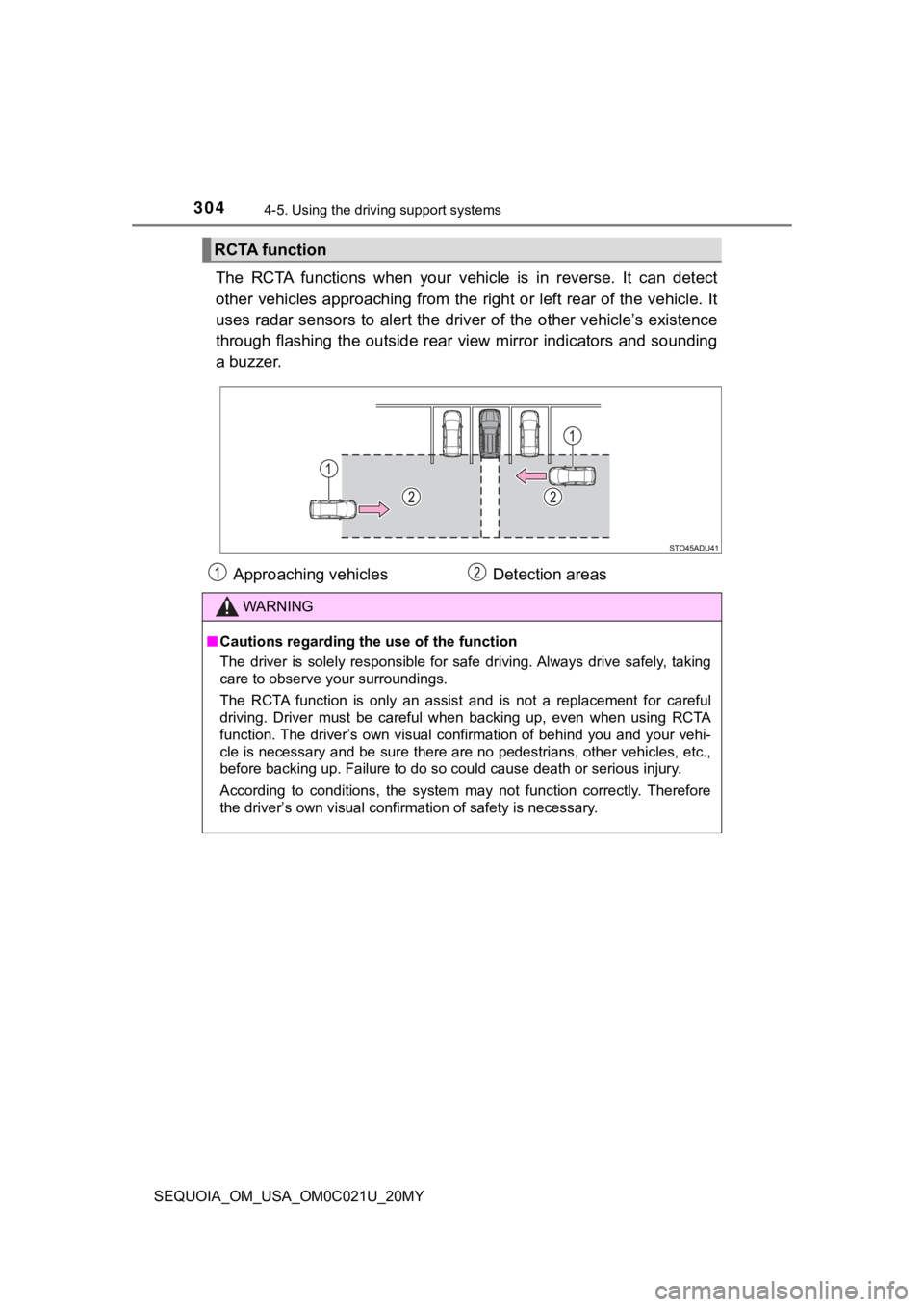
3044-5. Using the driving support systems
SEQUOIA_OM_USA_OM0C021U_20MY
The RCTA functions when your vehicle is in reverse. It can dete ct
other vehicles approaching from the right or left rear of the v ehicle. It
uses radar sensors to alert the driver of the other vehicle’s existence
through flashing the outside rear view mirror indicators and so unding
a buzzer.
RCTA function
Approaching vehicles Detection areas
WARNING
■Cautions regarding the use of the function
The driver is solely responsible for safe driving. Always drive safely, taking
care to observe your surroundings.
The RCTA function is only an assist and is not a replacement fo r careful
driving. Driver must be careful when backing up, even when usin g RCTA
function. The driver’s own visual confirmation of behind you an d your vehi-
cle is necessary and be sure there are no pedestrians, other ve hicles, etc.,
before backing up. Failure to do so could cause death or seriou s injury.
According to conditions, the system may not function correctly. Therefore
the driver’s own visual confirmation of safety is necessary.
Page 305 of 588
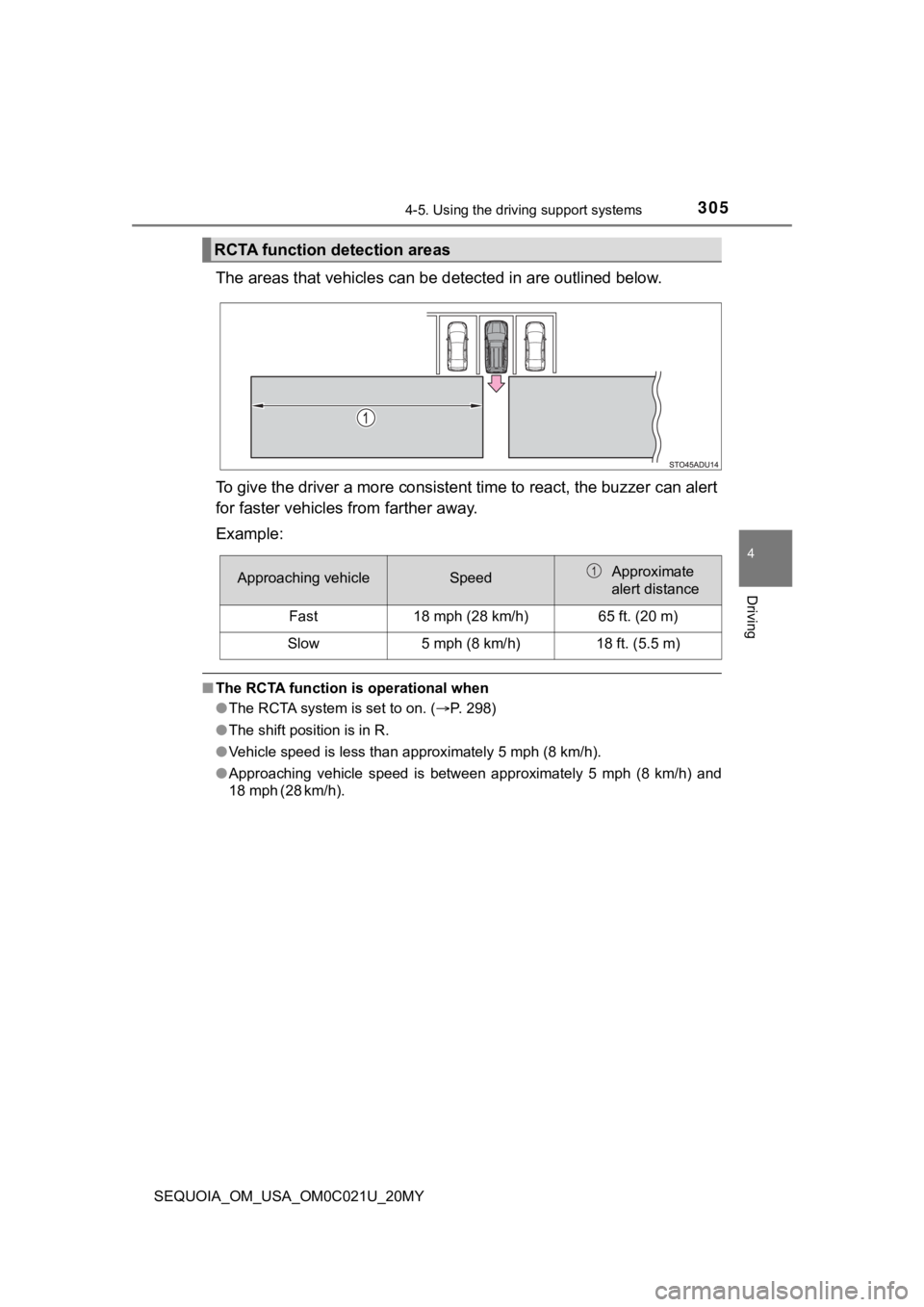
3054-5. Using the driving support systems
4
Driving
SEQUOIA_OM_USA_OM0C021U_20MY
The areas that vehicles can be detected in are outlined below.
To give the driver a more consistent time to react, the buzzer can alert
for faster vehicles from farther away.
Example:
■ The RCTA function is operational when
●The RCTA system is set to on. ( P. 298)
● The shift position is in R.
● Vehicle speed is less than approximately 5 mph (8 km/h).
● Approaching vehicle speed is between approximately 5 mph (8 km/ h) and
18 mph (28 km/h).
RCTA function detection areas
Approaching vehicleSpeedApproximate
alert distance
Fast18 mph (28 km/h)65 ft. (20 m)
Slow5 mph (8 km/h)18 ft. (5.5 m)
Page 306 of 588
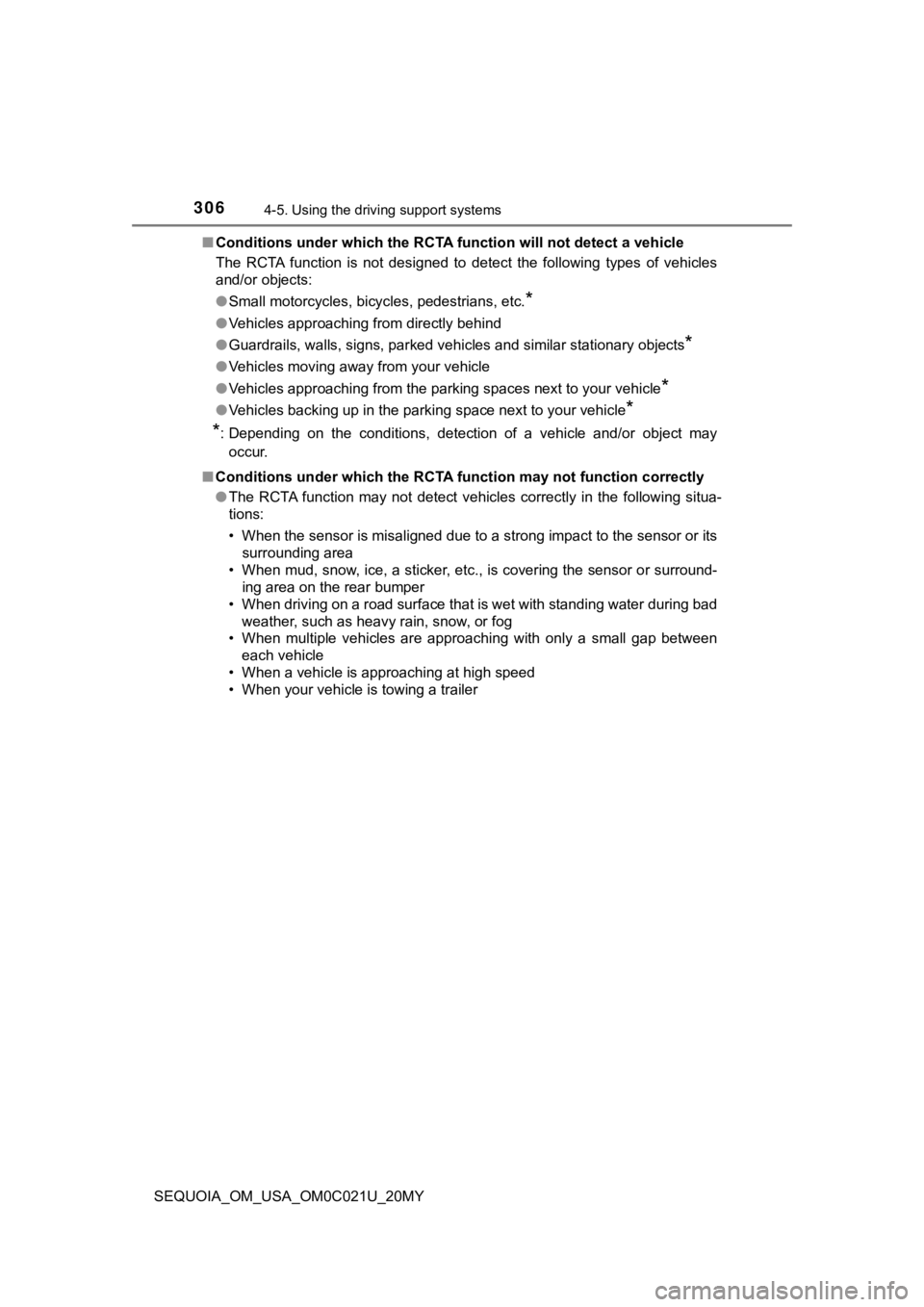
3064-5. Using the driving support systems
SEQUOIA_OM_USA_OM0C021U_20MY■
Conditions under which the RCTA function will not detect a vehicle
The RCTA function is not designed to detect the following types of vehicles
and/or objects:
● Small motorcycles, bicycles, pedestrians, etc.
*
●Vehicles approaching from directly behind
● Guardrails, walls, signs, parked vehicles and similar stationar y objects
*
●Vehicles moving away from your vehicle
● Vehicles approaching from the parking spaces next to your vehic le
*
●Vehicles backing up in the parking space next to your vehicle*
*
: Depending on the conditions, detection of a vehicle and/or obj ect may
occur.
■ Conditions under which the RCTA function may not function corre ctly
● The RCTA function may not detect vehicles correctly in the following situa-
tions:
• When the sensor is misaligned due to a strong impact to the se nsor or its
surrounding area
• When mud, snow, ice, a sticker, etc., is covering the sensor o r surround-
ing area on the rear bumper
• When driving on a road surface that is wet with standing water during bad
weather, such as heavy rain, snow, or fog
• When multiple vehicles are approaching with only a small gap b etween
each vehicle
• When a vehicle is approaching at high speed
• When your vehicle is towing a trailer
Page 307 of 588
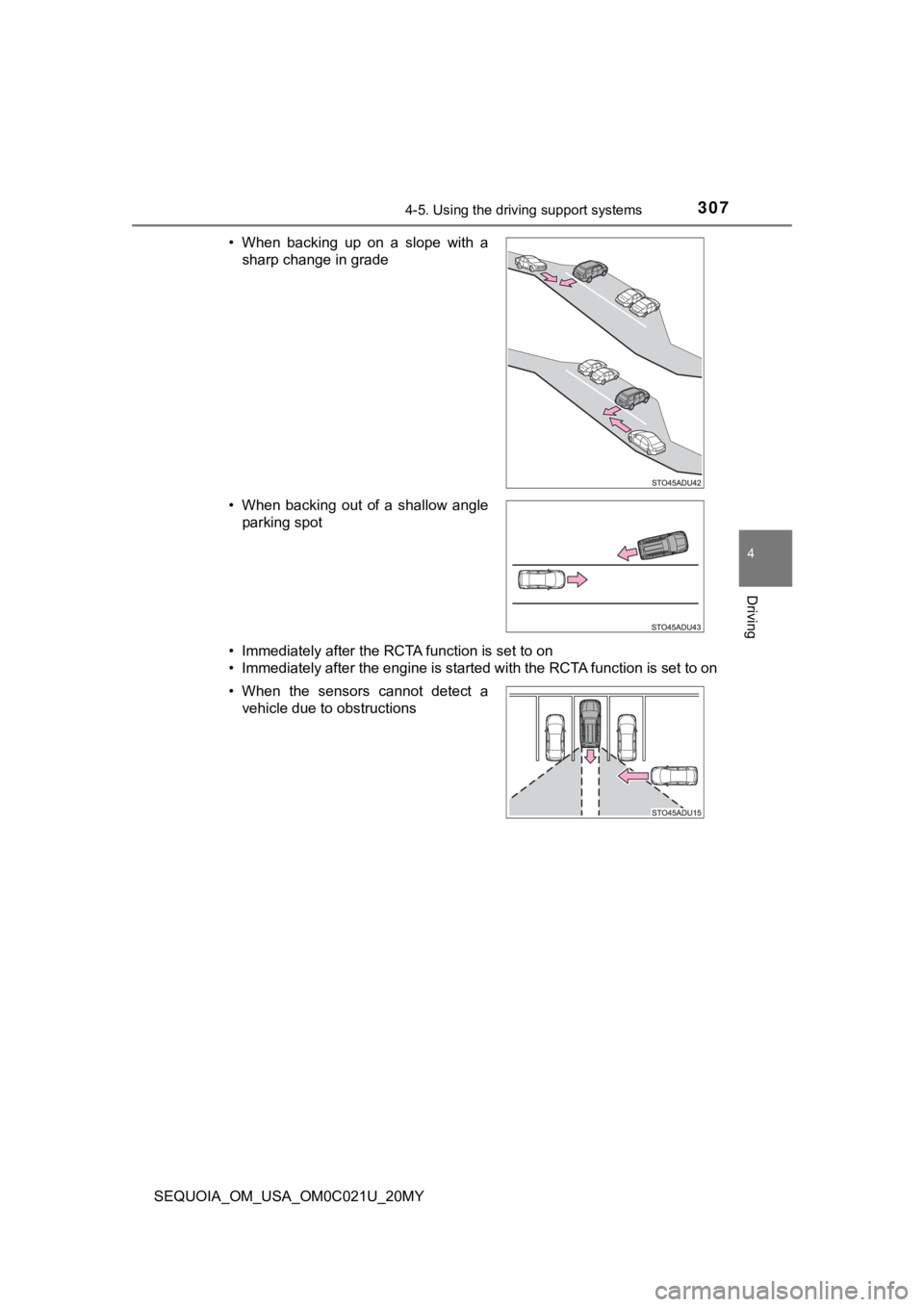
3074-5. Using the driving support systems
4
Driving
SEQUOIA_OM_USA_OM0C021U_20MY• Immediately after the RCTA function is set to on
• Immediately after the engine is started with the RCTA function
is set to on
• When backing up on a slope with a
sharp change in grade
• When backing out of a shallow angle parking spot
• When the sensors cannot detect a vehicle due to obstructions
Page 308 of 588
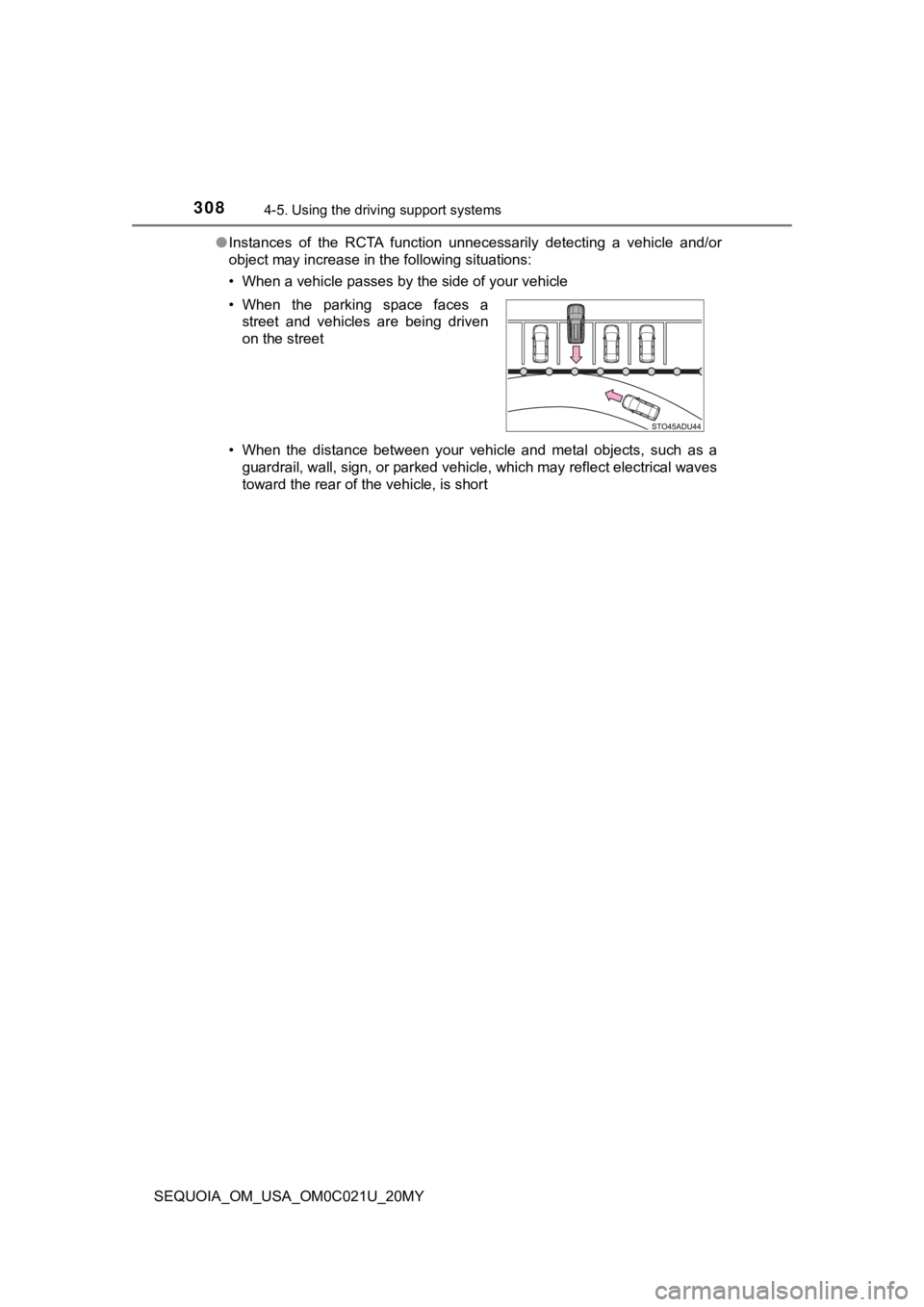
3084-5. Using the driving support systems
SEQUOIA_OM_USA_OM0C021U_20MY●
Instances of the RCTA function unnecessarily detecting a vehicl e and/or
object may increase in the following situations:
• When a vehicle passes by the side of your vehicle
• When the distance between your vehicle and metal objects, such as a
guardrail, wall, sign, or parked vehicle, which may reflect electrical waves
toward the rear of the vehicle, is short
• When the parking space faces a
street and vehicles are being driven
on the street
Page 309 of 588
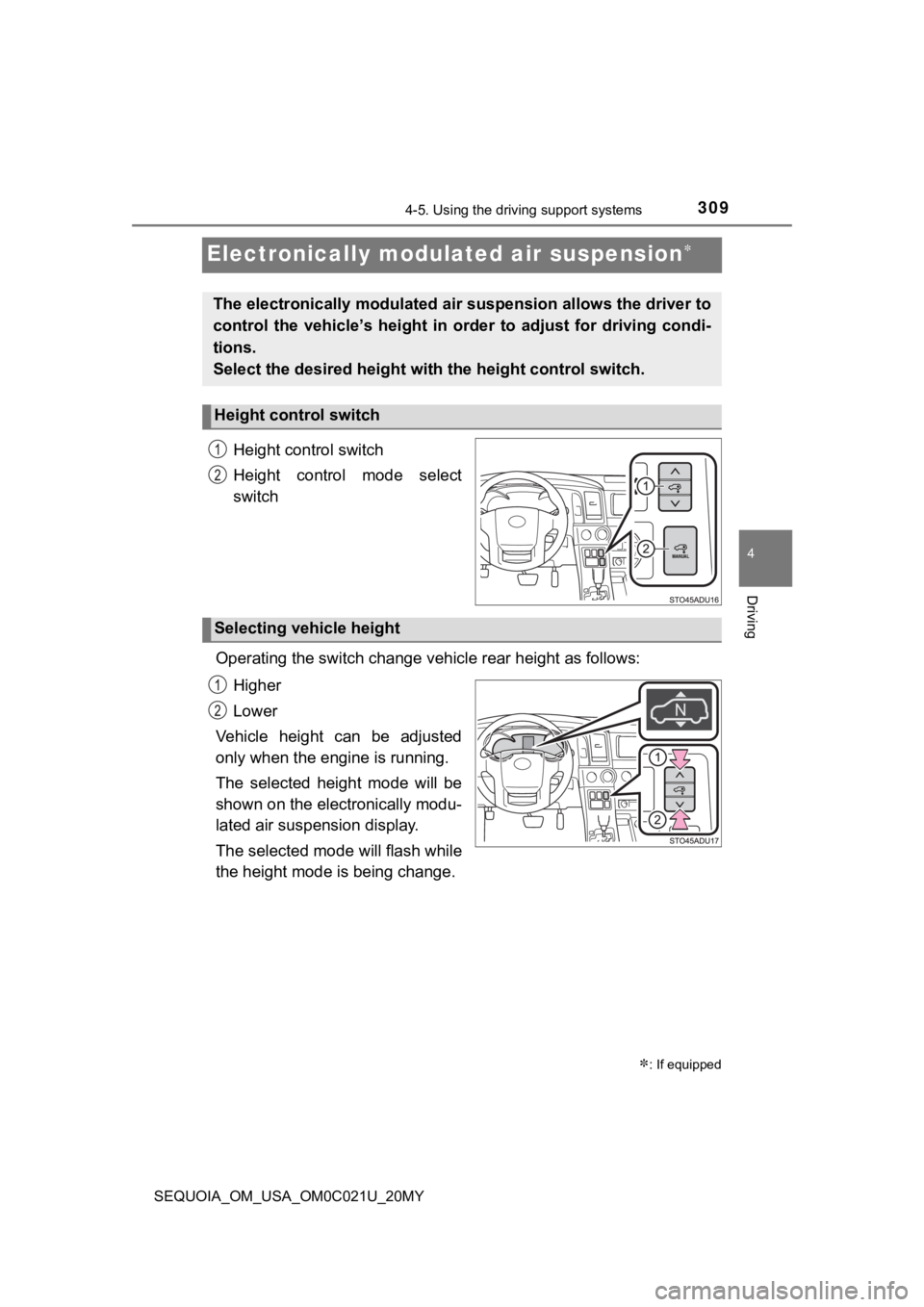
3094-5. Using the driving support systems
4
Driving
SEQUOIA_OM_USA_OM0C021U_20MY
Electronically modulated air suspension
Height control switch
Height control mode select
switch
Operating the switch change vehicle rear height as follows: Higher
Lower
Vehicle height can be adjusted
only when the engine is running.
The selected height mode will be
shown on the electronically modu-
lated air suspension display.
The selected mode will flash while
the height mode is being change.
: If equipped
The electronically modulated air suspension allows the driver t o
control the vehicle’s height in order to adjust for driving condi-
tions.
Select the desired height with the height control switch.
Height control switch
Selecting vehicle height
Page 310 of 588
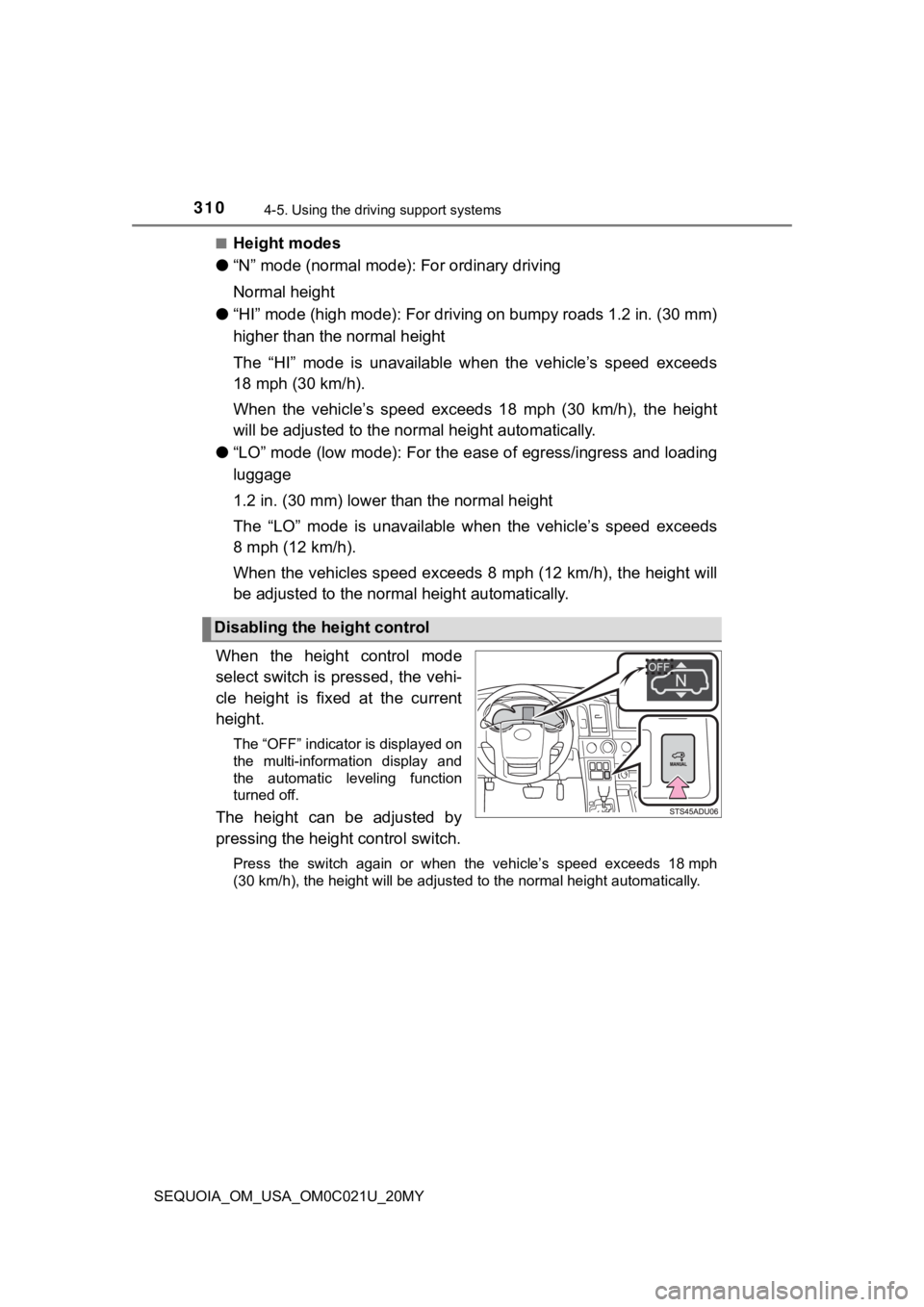
3104-5. Using the driving support systems
SEQUOIA_OM_USA_OM0C021U_20MY■
Height modes
● “N” mode (normal mode): For ordinary driving
Normal height
● “HI” mode (high mode): For driving on bumpy roads 1.2 in. (30 m m)
higher than the normal height
The “HI” mode is unavailable when the vehicle’s speed exceeds
18 mph (30 km/h).
When the vehicle’s speed exceeds 18 mph (30 km/h), the height
will be adjusted to the nor mal height automatically.
● “LO” mode (low mode): For the ease of egress/ingress and loadin g
luggage
1.2 in. (30 mm) lower than the normal height
The “LO” mode is unavailable wh en the vehicle’s speed exceeds
8 mph (12 km/h).
When the vehicles speed exceeds 8 mph (12 km/h), the height will
be adjusted to the normal height automatically.
When the height control mode
select switch is pressed, the vehi-
cle height is fixed at the current
height.
The “OFF” indicator is displayed on
the multi-information display and
the automatic leveling function
turned off.
The height can be adjusted by
pressing the height control switch.
Press the switch again or when the vehicle’s speed exceeds 18 mp h
(30 km/h), the height will be adjusted to the normal height auto matically.
Disabling the height control